Eight Verses of Training the Mind & Avalokiteshvara Empowerment
24/10/2014 21:03 (GMT+7) Font size:  
Vancouver, BC, Canada, 23 October 2014 - It was still dark as His Holiness the Dalai Lama drove through driving rain, weather locals say is typical of Vancouver, to the UBC Thunderbird Arena, this morning. He was making an early start in order to perform preparatory rituals for an Avalokiteshvara empowerment. 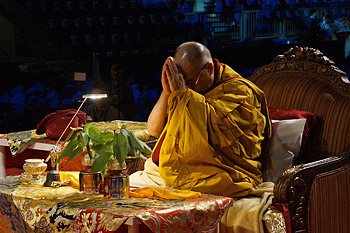
| His Holiness the Dalai Lama performing preparatory rituals before the start of his teachings in Vancouver, Canada on October 23, 2014. Photo/Jeremy Russell/OHHDL
|
Walking onto the stage of the almost empty hall, His Holiness scrutinized the images of the Buddha, Avalokiteshvara and 21 Taras in thangkas hanging behind the throne. He joined Tsengdok Rinpoche in lighting a large butter lamp set up before them, then took his seat before the mandala pavilion and commenced the preparatory procedures. As the hall gradually filled with people, he asked them to recite Om mani padme hung.
Seated on the teaching throne facing an audience of more than 5000, His Holiness explained that when possible he likes to begin Buddhist teachings with a recitation of the Mangala Sutta in Pali, but today there was no one present with the necessary skill. Instead, he asked for the Heart Sutra, a text common to all Buddhist countries that follow the Sanskrit tradition, to be recited in Chinese, Vietnamese and English. He then completed the recitation with verses of praise to the Buddha in Tibetan and the Heart Sutra mantra.
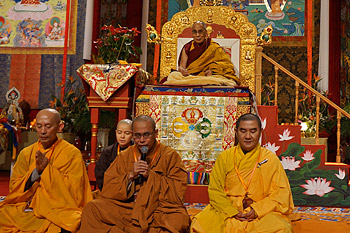
| Vietnamese monastics reciting the Heart Sutra at the start of His Holiness the Dalai Lama’s teachings in Vancouver, Canada on October 23, 2014. Photo/Jeremy Russell/OHHDL
|
He remarked that over the previous two days he had given talks from just a human point of view, consistent with the first of his lifetime commitments to make known the means for bringing about happier individuals in a more peaceful society. The second of his commitments, as a Buddhist, is to encourage inter-religious harmony, mindful of the common purpose and message of all major religious traditions. He pointed out that India is a living example that it is possible for a variety of religious traditions to live together, side by side, in respect and harmony. Since conflict in the name of religion is not confined to the past, but is rearing its head again today, this is significant.
Thirdly, he said he is a Tibetan and although he has retired from political responsibility, he retains a strong interest in preserving Tibetan culture. He remarked:
“Once the teaching of the Buddha reached Tibet, our culture became imbued with peace and non-violence. The proper way to pursue Buddhist teachings is not just to rely on faith, but to study. This reflects the tradition of Nalanda University that is at the core of the Tibetan Buddhist tradition. This morning I’m going explain a short text, the ‘Eight Verses for Training the Mind’ and in the afternoon I’ll be giving an Avalokiteshvara empowerment.”
He explained that the Buddha’s teachings are preserved in two major textual traditions: in Pali and in Sanskrit. The basis of the Pali tradition is the first of the Buddha’s teachings, the explanation of the Four Noble Truths. The Sanskrit tradition includes teachings from three occasions or Turnings of the Wheel of Dharma. The first also corresponds to the Four Noble Truths. The second involves the Perfection of Wisdom instructions and the third includes teachings such as the ‘Unravelling of Thought Sutra’ and explanations of Buddha nature. This tradition was upheld first at Taxila University and later at Nalanda University, where the majority of the classic Buddhist treatises were composed. The quality of Nagarjuna’s and Dharmakirti’s writings as well as those of their followers indicates that they wrote directly in Sanskrit.
His Holiness admitted that in ancient India, as well as in modern times, some scholars have challenged whether the Sanskrit tradition represents the authentic teaching of the Buddha. Masters such as Nagarjuna in his ‘Precious Garland’ defended the tradition, asserting that the Mahayana or Great Vehicle represents elaborations of teachings found in the Four Noble Truths. The third Noble Truth concerning cessation is explained more deeply in terms of emptiness in Mahayana texts. Likewise, the fourth Noble Truth concerning the path is explained more elaborately in the Third Turning of the Wheel’s account of the nature of consciousness. Therefore, His Holiness said, we may view the Mahayana scriptures as elaborations on the Four Noble Truths.
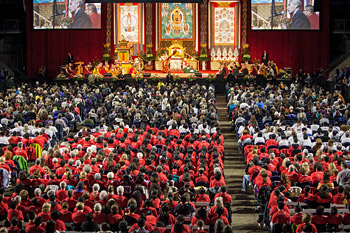
| A view of UBC Thunderbird Arena, venue for His Holiness the Dalai Lama’s teachings in Vancouver, Canada on October 23, 2014. Photo/Paula Wallis
|
He said the Vajrayana or Secret Mantra Vehicle has come under similar scrutiny. He conceded that there are many practices in common between Buddhist and Hindu tantra. They include prana or breathing yoga, visualization of the energy chakras, channels and drops and such practices as the yoga of inner heat. He said he has discussed these things with accomplished Hindu practitioners he has met. He said:
“I asked Khunu Lama Rinpoche how to differentiate the traditions and he told me it couldn’t be done of the basis of ritual, but on the basis of view. Buddhist practice is grounded in a view of non-self, whereas Hindu practice is grounded in a view of self or ‘atman’.”
His Holiness described the establishment of Buddhism in Tibet in 8th century by a trio known as the Abbot, Adept and King. The Abbot was Shantarakshita, an Indian master of monastic discipline, a noted philosopher and logician. Padmasambhava, the tantric adept was not a monastic. The result was that two communities arose in Tibet, the red-robed monastics and the white-robed tantrics. In India only the monastics formed a community. When an Indian monk tantric needed to leave the confines of the monastic community, he would generally go off on his own. His Holiness added:
“Professor LM Joshi, the late Indian scholar, told me he counted three conditions contributing to the decline of Buddhism in India. The first related to corruption as the monastic community became too interested in the accumulation of wealth, which undermined public respect for it. The second concerned the growth of excessive displays of behaviour related to tantra contrary to monastic norms, which again undermined public respect. The third condition was that rulers began to lose interest in supporting Buddhist institutions.”
In this connection His Holiness recounted the report of a Chinese Buddhist some years ago who told him that Tibetan lamas were coming to China in the guise of great masters. However, it eventually emerged that they were primarily interested in money and women. With regret, His Holiness answered pleas for his intervention saying there was little he could do from India. Nevertheless, he strongly recommended Chinese Buddhists make themselves familiar with the proper qualities of a spiritual master and measure such teachers against that standard. He said this advice applied equally in the West too.
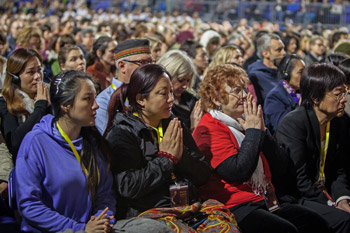
| Some of the more than 5,000 people attending His Holiness the Dalai Lama’s teachings in Vancouver,Canada on October 23, 2014. Photo/Paula Wallis
|
The practice of tantra as described in the practice manuals presupposes an understanding of emptiness. Deity yoga involves first reflecting on emptiness and that very mind arising in the form of a meditational deity. Such meditation techniques are sophisticated and allow the practitioner to employ a subtler level of consciousness than the ordinary mind. This is not only powerful, but is the only way to overcome the subtle obstructions to knowledge. His Holiness remarked:
“We have two enemies, the self-cherishing or self-centred mind and the misconception of self. Understanding emptiness can help counter these. I make no claim to have understood emptiness, but I feel I can say I’m almost there and I can assure you of the power of the practice. Crucial to Buddhism in general, but especially the Nalanda tradition, is the need to use our intelligence and transform our emotions. I’m an older person now, but I still consider myself a student. Also I usually describe the Tibetan tradition as a complete form of Buddhism, because it’s a system that allows you to employ the Pali and Sanskrit traditions, the Mahayana and Vajrayana in a single session.”
The ‘Eight Verses for Training the Mind’ comes from the Kadampa tradition, which His Holiness said began with Atisha in whom the lineages of the vast and profound traditions were combined. The author, Geshe Langri Tangpa, traced the transmission of this teaching back through Sharawa, Potowa, and Drom-ton-pa to Atisha. Its subject is the conventional and ultimate awakening mind and it is a text His Holiness is personally fond of. He has memorized it and recites it to himself whenever he has the opportunity, such as when he finds himself delayed in an airport. He read it through quickly, succinctly summarizing each verse.
The first emphasizes the proper attitude to others, the second that we should see ourselves as lower than them. The third warns us to beware of disturbing emotions, the fourth that we should value difficult beings. The fifth advises us to accept defeat and give victory to others, the sixth that our expectation that good be repaid by good will be disappointed. The seventh verse refers to the practice of giving and taking, exchanging self and others, while the last two lines of the eighth clarify the view.
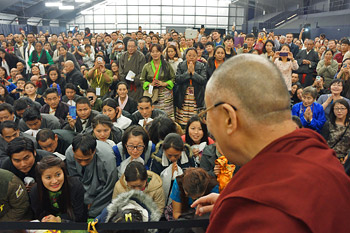
| His Holiness the Dalai Lama meeting with members of the Tibetan community in Vancouver, Canada on October 23, 2014. Photo/Jeremy Russell/OHHDL
|
After lunch His Holiness held a meeting with about 1000 Tibetans. 270 were from Vancouver, while the rest came mostly from Calgary, Seattle and Portland. A traditional song was followed by a reading of the local representative’s report. This mentioned the fundraising support the local community are trying to give Tibetans newly arriving from Arunachal Pradesh as part of the latest wave of Tibetan resettlement in Canada. The report also stated how appalled Vancouver Tibetans are by the demonstrations by Shugden supporters against His Holiness. They called them a source of hurt for Tibetans all over the world.
In his response, His Holiness said how happy he was that they all had this opportunity to meet.
“It’s 55 years since we came into exile, and new generations are raising their own children. We remain dedicated to our religion and culture, while if anything the Tibetan spirit has grown stronger. The Tibetan cause remains fresh and attracts interest because of our religion and culture. As I explained earlier, our Buddhist tradition is the only one to employ logic and reasoning. And it is still true that the Nalanda tradition is most accurately explained in the Tibetan language. While Nalanda University lies in ruins in India, the tradition it gave rise to is alive amongst Tibetans. This is significant since there are estimated to be 4-500 million Buddhists in China today, many of whom have a growing interest in these things.”
Taking up remarks about the Dolgyal / Shugden issue, His Holiness said it began at the time of the 5th Dalai Lama, who wrote about it in his autobiography, mentioning the harm the spirit was doing the Dharma and sentient beings. He said the 5th and 13th Dalai Lamas had restricted the practice, but even during the time of the 7th prominent masters had opposed it. In this context, he said it was a mistake that he took up the practice, but when he saw it was a mistake he stopped.
“I feel sorry for these demonstrators,” he said, “because they are misinformed. For example, in Hamburg they displayed pictures of me wearing a Muslim skull-cap and said I was a Muslim instead of a Buddhist. I’m not worried, the truth will out. Some of the demonstrators are Tibetans. I feel sorry for them; don’t feel anger towards them.”

| His Holiness the Dalai Lama giving the Avalokiteshvara empowerment in Vancouver, Canada on October 23, 2014. Photo/Paula Wallis
|
The afternoon session was dedicated to giving the one thousand armed Avalokiteshvara empowerment. His Holiness quoted Gungthang Tenpai Dronmey’s advice not to take the empowerment in order to secure wealth or longevity. Tantra is meant for attaining Buddhahood. During the course of proceedings he led the audience in taking the Bodhisattva vows. At the end, he said:
“These three days in Vancouver are over; I enjoyed them, thank you. Keep the points we have talked about in mind. Try to put them into practice, but don’t do so with short-sighted expectations. Nagarjuna says the Buddha’s path is intended to liberate innumerable beings over immeasurable ages. Thank you, and see you next time.”  http://www.dalailama.com/
|